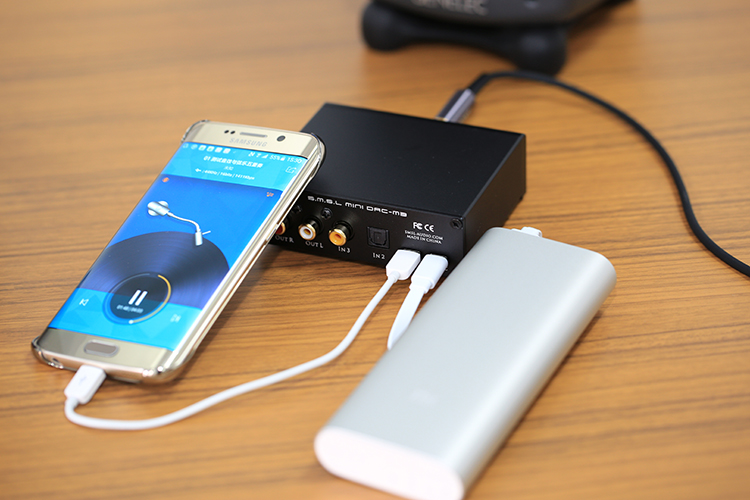Hi
I've stumbled upon this picture today:

In it, we can see a SMSL M3 DAC (based on CS4398). In this picture it is powered by a Power Bank, and inputted by a Smartphone. The thing that surprises me here, is that when you want to connect a USB Device to a Smartphone, you need to use a USB OTG adapter. But here, we see a USB cable.
So does it mean that this is not a simple USB cable, but an OTG Cable? Or, can a DAC (and generally USB Devices) be connected to a phone without an OTG Adapter, and simply via any cable? I hope anyone tried it and knows the answer
Thank you
I've stumbled upon this picture today:

In it, we can see a SMSL M3 DAC (based on CS4398). In this picture it is powered by a Power Bank, and inputted by a Smartphone. The thing that surprises me here, is that when you want to connect a USB Device to a Smartphone, you need to use a USB OTG adapter. But here, we see a USB cable.
So does it mean that this is not a simple USB cable, but an OTG Cable? Or, can a DAC (and generally USB Devices) be connected to a phone without an OTG Adapter, and simply via any cable? I hope anyone tried it and knows the answer
Thank you
Last edited:
There is an out too, headphones are connected to the Headphones Out on the front..Lots of in but no out ....
A marketing picture for the DACA marketing picture for an app?
Yes: Shenzhen ShuangMuSanLin Electronic Co., Ltd.You have any links ?
it has a 24 bit/192 kHz sample rate via optical and coaxial, and a 24 bit/96 kHz sample rate via USB.
Usb 1.1 ?? "max 24 bit/96 kHz " vs spdif @24 bit/192 kHz !!!
Any usb dac worth it's salt would outstrip spdif ...🙂
Last edited:
Interesting, I did not notice it..Usb 1.1 ?? "max 24 bit/96 kHz " vs spdif @24 bit/192 kHz !!!
This mostlikely due to using a SA9023 USB chip. SaviAudio
It is one of the most common USB Chips, you see it a lot in the SA9023+ES9018K2M combination.
The reason it's so commonly used, is because it is supported not just by computers, but also by older smartphones. I assume that's why the chose it, and not a newer USB chip.
BTW, note that in many cases, for most sources, 48KHz should suffice, and above that will not gain any improvement in sound, so the chase for a higher parameters (bit Rate, Sample Rate) will not produce any audible result.
So the fact that on USB you will get max of 96KHz should not be a disadvantage here.
(and in any case, if someone so really needs 192KHz, and will actually hear a difference by using it, he can connect a USB-to-Optical adapter to his computer, and then connect to this DAC using an optical cable.. thus getting even a complete electric isolation between his computer and his audio components)
Last edited:
Lots of in but no out ....
A marketing picture for an app?
You have any links ?
Both devices are USB slave devices so I don't think they will talk to each other. One needs to be a master like your pc is.
I have done a bit with USB on USB scopes and USB LC meters so know enough for that.
Hi Nigel
By default, it is a Slave, so when you connect it to a computer, the computer is the host.
But if the smartphone's USB port supports OTG (most smartphones from the last 5 years support OTG), and you use an OTG Cable, then the smartphone can be a host, instead of a device (slave). So then, with the OTG cable, you can connect USB Slave devices (e.g. a USB Flash Drive, an Audio Profile USB Device, etc.) to it.
BTW, the answer to my original question here, is that the cable is USB-C. In USB-C, things work differently than before: there's no more a need to use a USB OTG cable in order to connect slave devices to the phone. It is a feature of USB-C, that prevents the need for a special cable for such a situation.
More info about USB-C and the no-need for OTG cable can be read here: http://www.ti.com/lit/wp/slly017/slly017.pdf
A smartphone can be both a Slave or a Master device.Both devices are USB slave devices so I don't think they will talk to each other.
By default, it is a Slave, so when you connect it to a computer, the computer is the host.
But if the smartphone's USB port supports OTG (most smartphones from the last 5 years support OTG), and you use an OTG Cable, then the smartphone can be a host, instead of a device (slave). So then, with the OTG cable, you can connect USB Slave devices (e.g. a USB Flash Drive, an Audio Profile USB Device, etc.) to it.
BTW, the answer to my original question here, is that the cable is USB-C. In USB-C, things work differently than before: there's no more a need to use a USB OTG cable in order to connect slave devices to the phone. It is a feature of USB-C, that prevents the need for a special cable for such a situation.
More info about USB-C and the no-need for OTG cable can be read here: http://www.ti.com/lit/wp/slly017/slly017.pdf
- Status
- Not open for further replies.
- Home
- Source & Line
- PC Based
- Connecting a USB DAC to a Smartphone